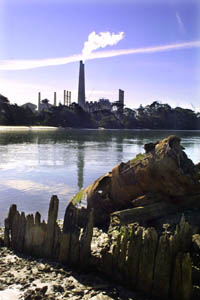![[MetroActive News&Issues]](http://metroactive.com/gifs/news468.gif)
[ Santa Cruz | MetroActive Central | Archives ]
Sloughing the Dragon
Duke Energy Corporation hopes to expand Moss Landing Power Plant without endangering Elkhorn Slough, but the Sierra Club has its doubts
By Christa Fraser
POISED AT THE CENTER of Monterey Bay, at the mouth of Elkhorn Slough, the Moss Landing Power Plant looks like the City of Oz minus the emeralds. Yet with California on the brink of one of the worst energy crises in years, what the plant has to offer may be more valuable than jewels and much more controversial than discovering the wizard behind the curtain.
After a year of meetings between representatives of the California Energy Commission and various environmental groups, Duke Energy Corporation's Moss Landing Power Plant expansion plans were approved Oct. 27, 2000. The project aims to reduce air emissions and generate more power for Californians. Crews are now working to complete a $525-million upgrade that will increase production to 2,560 megawatts, which is more than any other plant in the state and enough to power an extra 2.5 million households.
The plant, previously owned by PG&E, has been operating since the 1950s and converted from fossil fuels to compressed natural gas in 1967. Eight 225-foot-high stacks and 19 oil tanks will be removed as part of the modernization plan.
The new plant will be less polluting and will use a smaller volume of sea water for its once-through cooling system, which is essentially a radiator that keeps the plant from overheating. However, while Duke has made attempts to mitigate the environmental damage from construction and the long-term environmental impacts of the plant, the plans remain controversial due to entertainment of organisms and warm-water discharge into the Bay.
Up to 28 percent of the water volume of the Elkhorn Slough and the harbor will be sucked into the intake valves during peak capacity. This amount will result in the loss of up to 40 percent of the primary productivity of the slough, namely the larvae and eggs that form the base of the food chain for both the Monterey Bay and Elkhorn Slough.
"Even with no human intervention, not every egg or larvae makes it to the adult stage, but all stages are a part of the food chain," explains Patricia Madducheck of the Sierra Club. Because these primary food sources are lost, it is feasible that species higher on the food chain, such as the threatened southern sea otter, may be further endangered. "These are not animals that are going to be happy with a gift certificate to Pizza Hut," Madducheck says.
The release of warm water from the cooling process 600 feet offshore into Monterey Bay National Marine Sanctuary may adversely affect ocean species only able to survive within specific temperature fluctuations.
Greens Storm: Elkhorn Slough will soon share its northern borders with hackers and homesites.
A coalition of organizations--including the Center for Marine Conservation, the Sierra Club and Save Our Shores--originally protested the plans. Duke offered to mitigate environmental impacts by establishing a $7.5-million fund to be overseen by the Elkhorn Slough Foundation. Furthermore, Duke has given both Monterey Bay Aquarium and Save Our Shores grants for monitoring and research.
The Sierra Club has filed an appeal on the basis that the best available technology was not properly considered, even though Duke was asked to present alternative plans for the intake and discharge systems prior to approval.
With the exception of the Sierra Club, the other organizations in the coalition decided not to pursue an appeal and accepted the mitigation proposal instead. One reason, according to Vicky Nichols of Save Our Shores, is that the organizations are not in a position to sue Duke. Another reason is California's current energy crisis. The early days of December saw a peak usage of nearly 95 percent of available energy, with rolling blackouts becoming a reality this month.
At present, the California Energy Commission has plans for 22 new power plants and four retrofits on the table, but the Moss Landing expansion will fill an immediate demand. Nonetheless, as the California Regional Water Quality Control Board wrote in a report two days after the project was accepted, "It is impossible to precisely quantify the resulting impact of the losses on the overall slough/harbor ecosystem and the long-term effects on species populations."
[ Santa Cruz | MetroActive Central | Archives ]
Copyright © Metro Publishing Inc. Maintained by Boulevards New Media.
![]()

![[line]](/gifs/line.gif)
![[line]](/gifs/line.gif)
From the January 24-31, 2001 issue of Metro Santa Cruz.